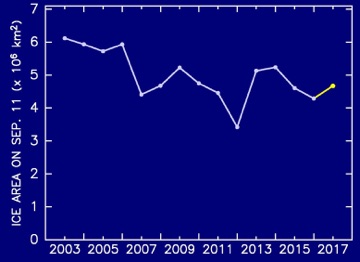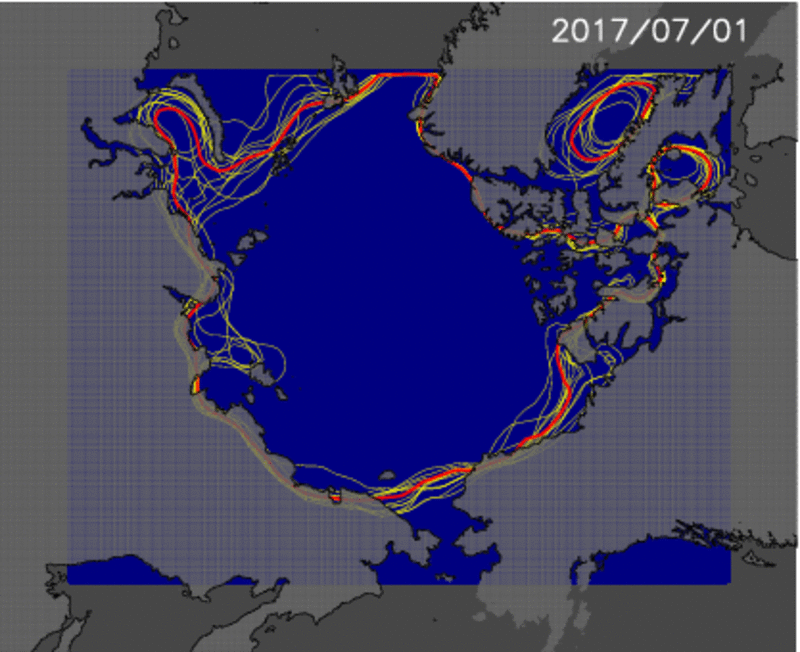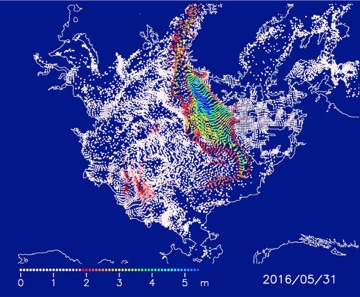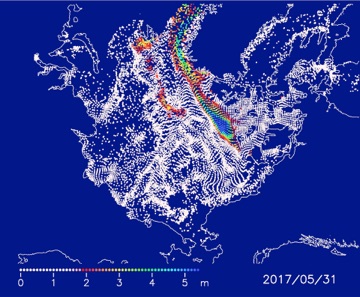Method of Prediction:Tracking of sea ice from winter to spring
Figure1:Predicted sea ice cover on September 11, 2017.
Figure 3:Animation of predicted Arctic ice extent from the July 1 to the September 15. Yellow and green lines indicates the ice edge of the same day for 2015 and 2016.
Figure 2:The interannual change of minimum extent since 2003. Value of 2017 is predicted one.
Figure 6:Distribution of particles for May 31, 2016, which are first arrayed over the ice-covered area on December 1, 2015 and are moved based on the satellite-derived daily-ice velocity. The color bar indicates the thickness of the ice on December 1, 2015.
Figure 7:Distribution of particles for May 31, 2017, which are first arrayed over the ice-covered area on December 1, 2016 and are moved based on the satellite-derived daily-ice velocity. The color bar indicates the thickness of the ice on December 1, 2016.
Figure 5:Animation of distributed particles’ movements during December 1, 2015 through May 31, 2016. The color bar indicates the thickness of the ice on December 1, 2016.
If you have any questions, please contact kimura_n@aori.u-tokyo.ac.jp
This work was partly supported by
Arctic Challenge for Sustainability Project.
The way of this prediction is basically same as the first report.
We distributed particles homogeneously over the Arctic sea ice on December 1, and traced the trajectories of the particles to May 31. Based on the relationship (linear regression line) between yearly particle concentration on May 31 and ice concentration on a specific day in summer, we predicted the ice area on the day.
1. Minimum ice extent in September will be about 4.67 million square kilometer.
2. Ice retreat in the Laptev Sea and Chukchi Sea will be faster than normal years.
3. Sea routes of Russian side and Canadian side will both open.
Russian side will open around August 20, and the Canadian side except for
Canadian archipelago will open around July 20.
Sea ice extent on September 11, which is the minimal area phase of Arctic sea ice, is expected to be 4.67 million square kilometer, which is 8% larger than the last year and 2% larger than the first report.
Sea ice in the Laptev Sea and Chukchi Sea is expected to be thin and retreat quickly. On the other hand, sea ice in the East Siberian Sea will retreat slowly with nearly same speed as normal years. Sea routes of the Russian side will open around August 20, which is almost equal to the last year.
On the Canadian side, sea ice in the Beaufort Sea is expected to be thick and retreat slowly compared with the last year. The sea routes of the Canadian side except for Canadian archipelago will open around the July 20.
※Prediction map is also available in Arctic Data Archive System of National Institute of Polar Research.
Arctic Sea Ice Forecast 2017
Second Report:June 28, 2017
Noriaki Kimura, Hiroyasu Hasumi
Atmosphere and Ocean Research Institute, The university of Tokyo

Figure 4:Animation of the ice edge (30% of ice concentration) for 2003-2016 (yellow contours) and 2017 (predicted: red contour).







